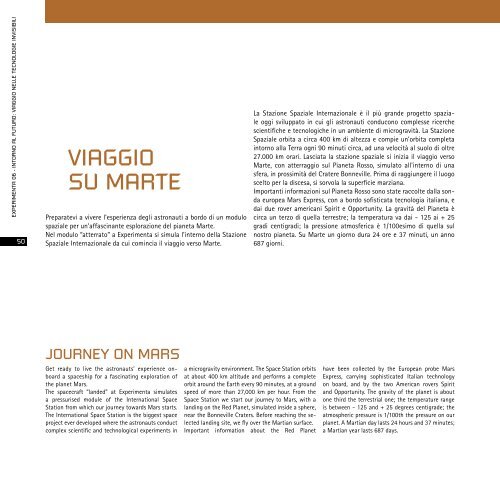Catalogo Experimenta 06
Catalogo Experimenta 06
Catalogo Experimenta 06
Create successful ePaper yourself
Turn your PDF publications into a flip-book with our unique Google optimized e-Paper software.
EXPERIMENTA <strong>06</strong> - INTORNO AL FUTURO: VIAGGIO NELLE TECNOLOGIE INVISIBILI<br />
50<br />
VIAGGIO<br />
SU MARTE<br />
Preparatevi a vivere l’esperienza degli astronauti a bordo di un modulo<br />
spaziale per un’affascinante esplorazione del pianeta Marte.<br />
Nel modulo “atterrato” a <strong>Experimenta</strong> si simula l’interno della Stazione<br />
Spaziale Internazionale da cui comincia il viaggio verso Marte.<br />
JOURNEY ON MARS<br />
Get ready to live the astronauts’ experience onboard<br />
a spaceship for a fascinating exploration of<br />
the planet Mars.<br />
The spacecraft “landed” at <strong>Experimenta</strong> simulates<br />
a pressurised module of the International Space<br />
Station from which our journey towards Mars starts.<br />
The International Space Station is the biggest space<br />
project ever developed where the astronauts conduct<br />
complex scientific and technological experiments in<br />
a microgravity environment. The Space Station orbits<br />
at about 400 km altitude and performs a complete<br />
orbit around the Earth every 90 minutes, at a ground<br />
speed of more than 27,000 km per hour. From the<br />
Space Station we start our journey to Mars, with a<br />
landing on the Red Planet, simulated inside a sphere,<br />
near the Bonneville Craters. Before reaching the selected<br />
landing site, we fly over the Martian surface.<br />
Important information about the Red Planet<br />
La Stazione Spaziale Internazionale è il più grande progetto spaziale<br />
oggi sviluppato in cui gli astronauti conducono complesse ricerche<br />
scientifiche e tecnologiche in un ambiente di microgravità. La Stazione<br />
Spaziale orbita a circa 400 km di altezza e compie un’orbita completa<br />
intorno alla Terra ogni 90 minuti circa, ad una velocità al suolo di oltre<br />
27.000 km orari. Lasciata la stazione spaziale si inizia il viaggio verso<br />
Marte, con atterraggio sul Pianeta Rosso, simulato all’interno di una<br />
sfera, in prossimità del Cratere Bonneville. Prima di raggiungere il luogo<br />
scelto per la discesa, si sorvola la superficie marziana.<br />
Importanti informazioni sul Pianeta Rosso sono state raccolte dalla sonda<br />
europea Mars Express, con a bordo sofisticata tecnologia italiana, e<br />
dai due rover americani Spirit e Opportunity. La gravità del Pianeta è<br />
circa un terzo di quella terrestre; la temperatura va dai - 125 ai + 25<br />
gradi centigradi; la pressione atmosferica è 1/100esimo di quella sul<br />
nostro pianeta. Su Marte un giorno dura 24 ore e 37 minuti, un anno<br />
687 giorni.<br />
have been collected by the European probe Mars<br />
Express, carrying sophisticated Italian technology<br />
on board, and by the two American rovers Spirit<br />
and Opportunity. The gravity of the planet is about<br />
one third the terrestrial one; the temperature range<br />
is between - 125 and + 25 degrees centigrade; the<br />
atmospheric pressure is 1/100th the pressure on our<br />
planet. A Martian day lasts 24 hours and 37 minutes;<br />
a Martian year lasts 687 days.


